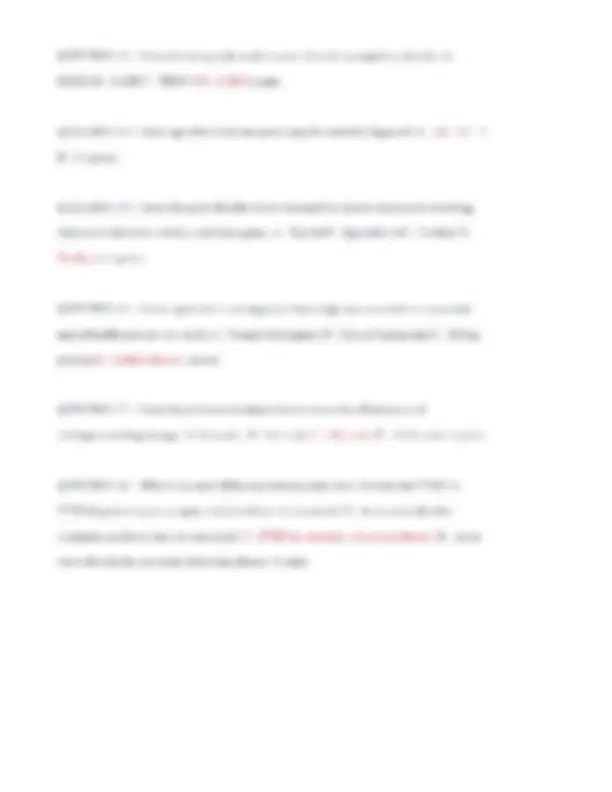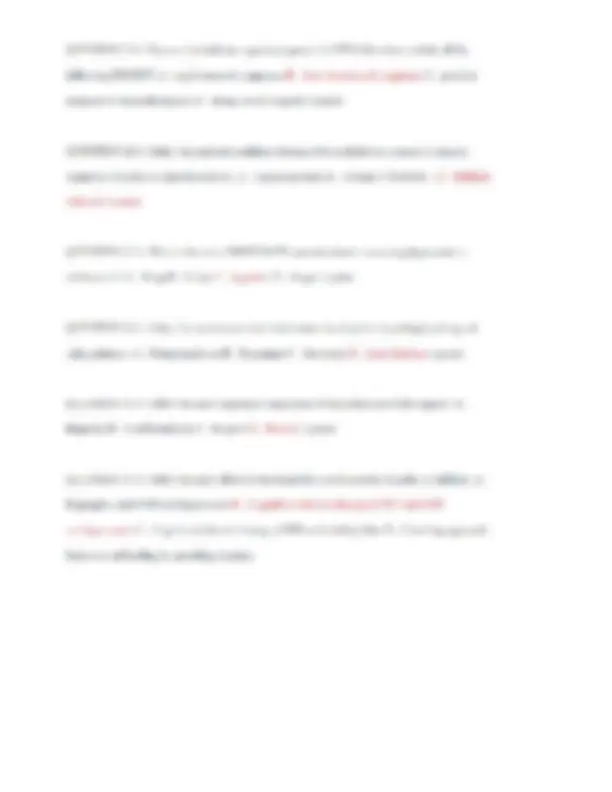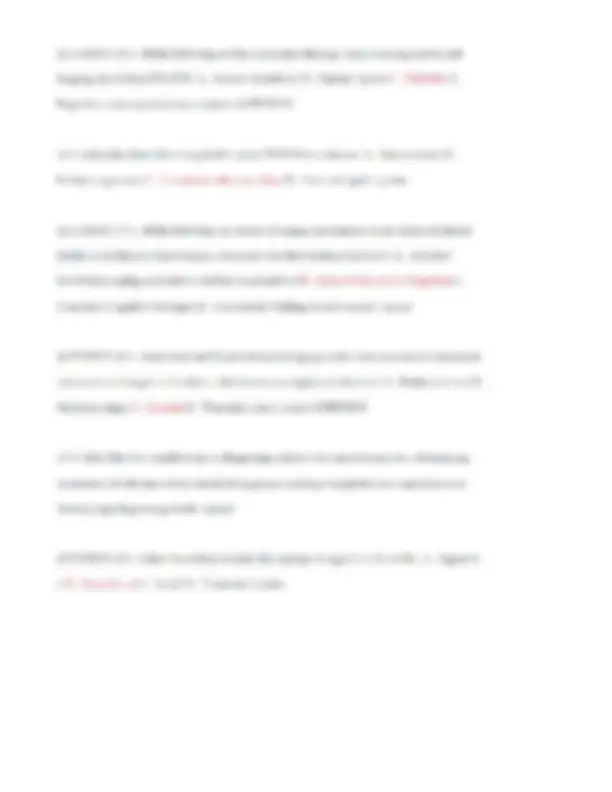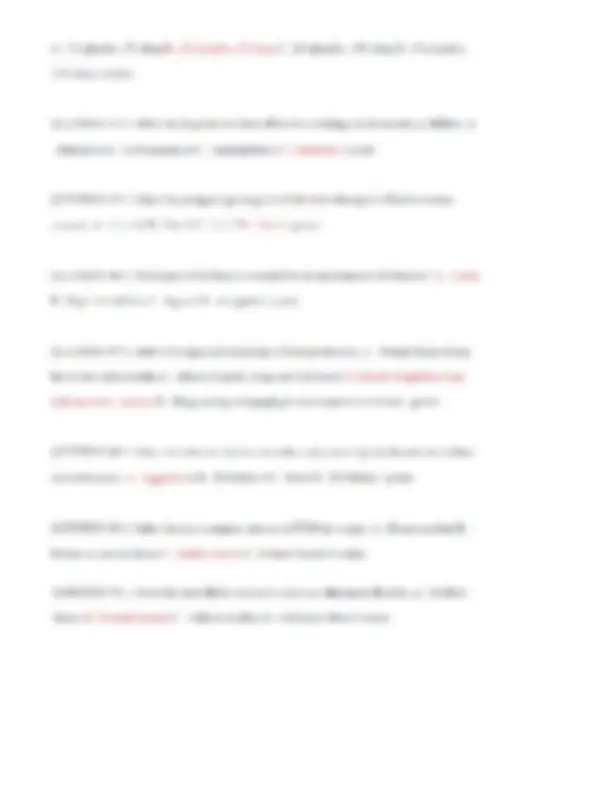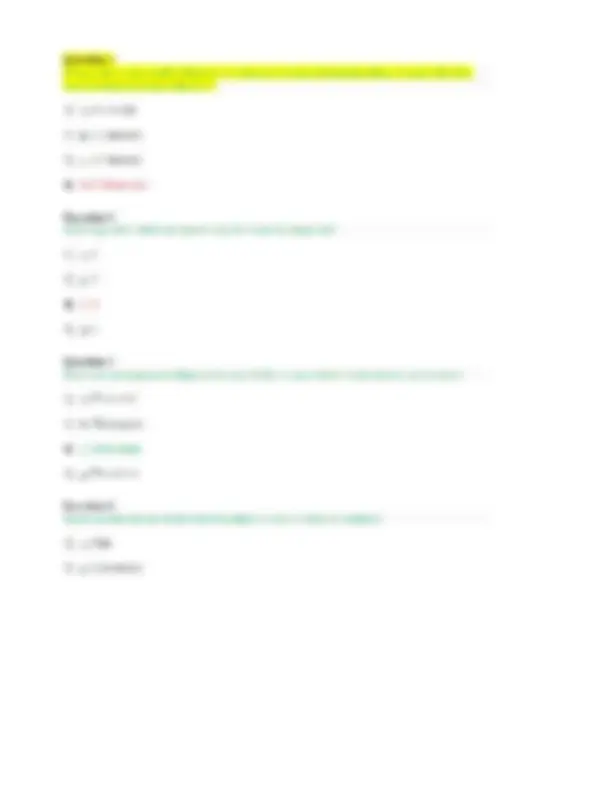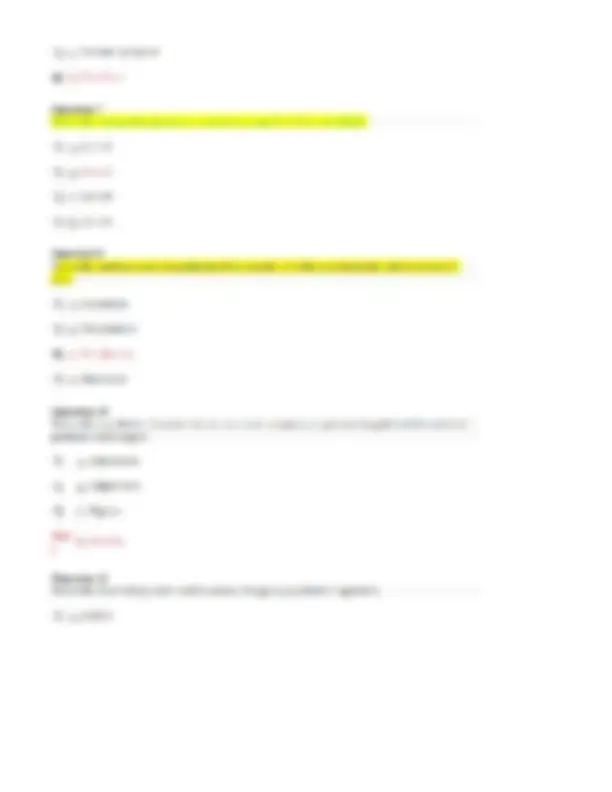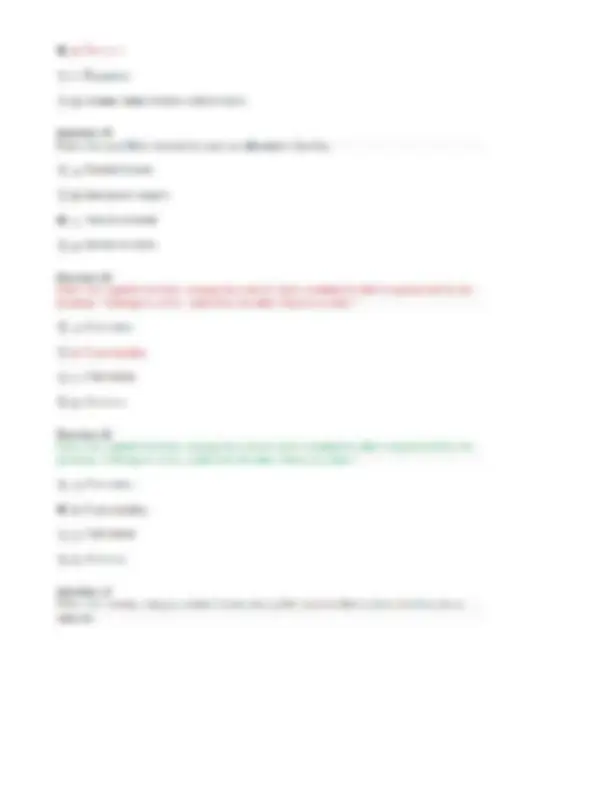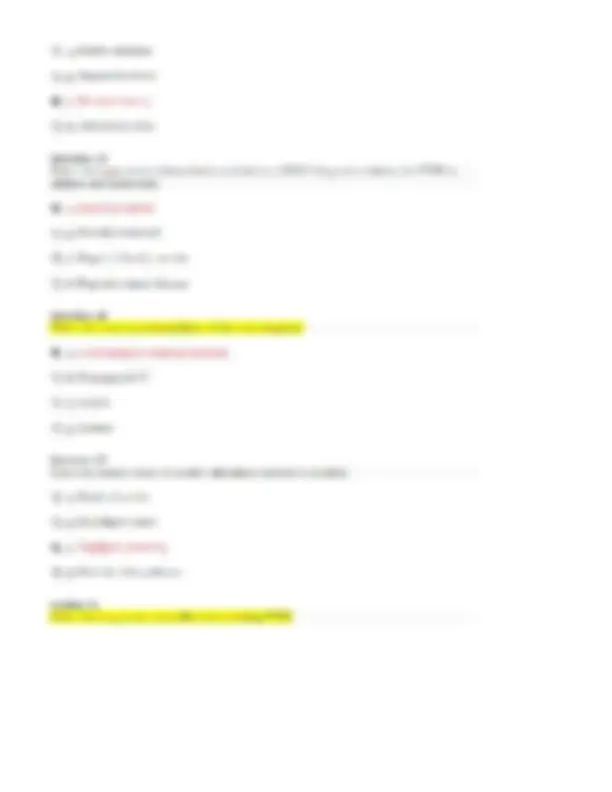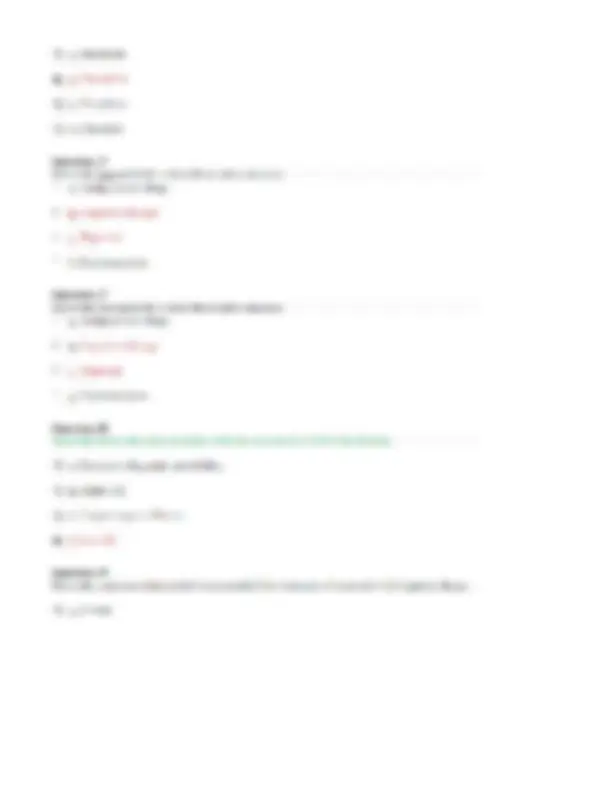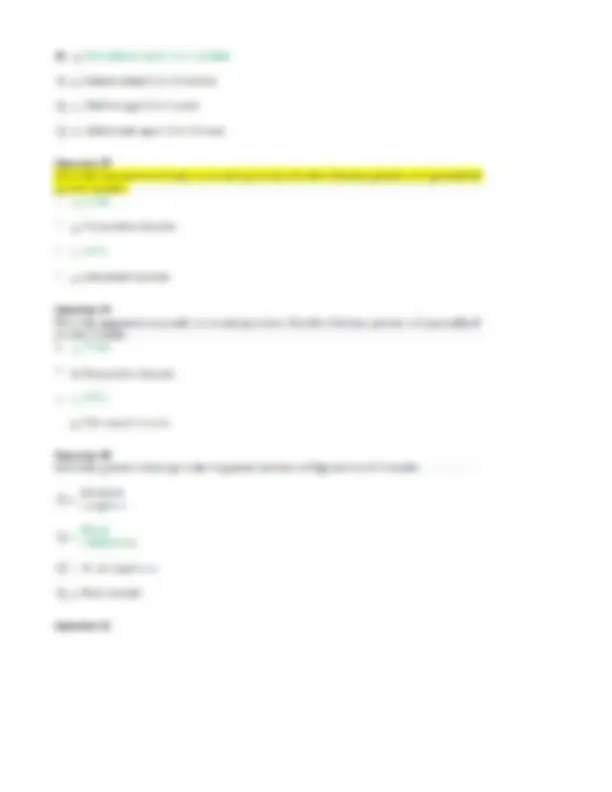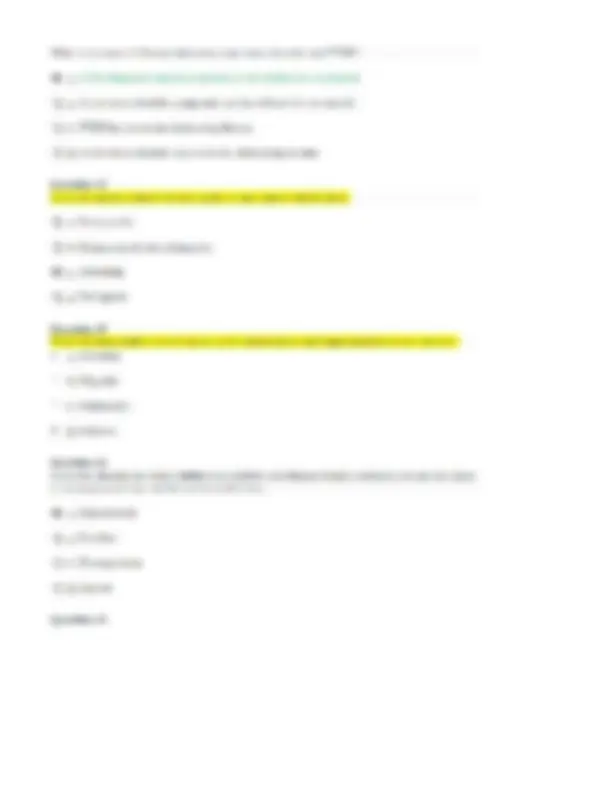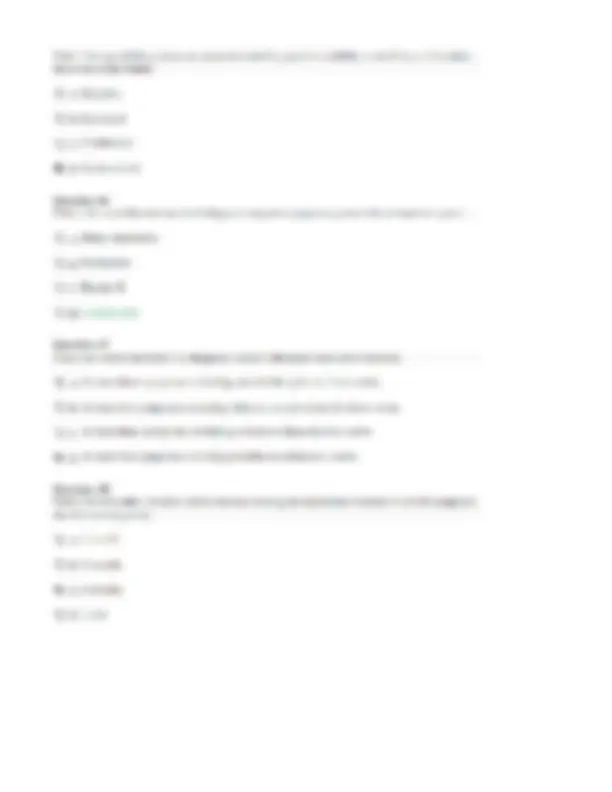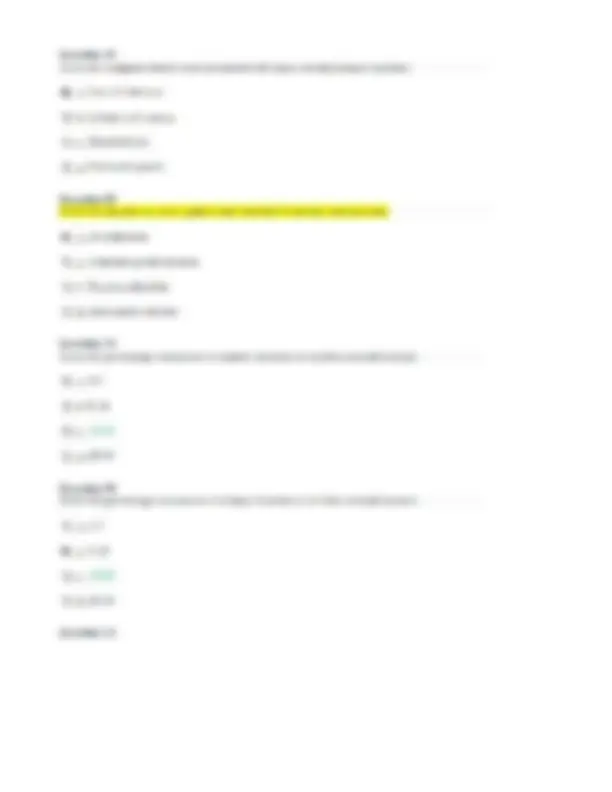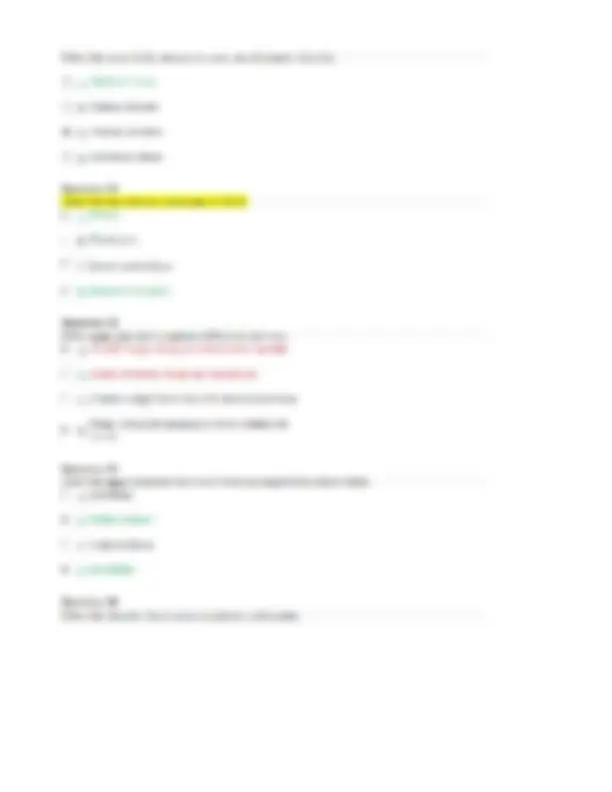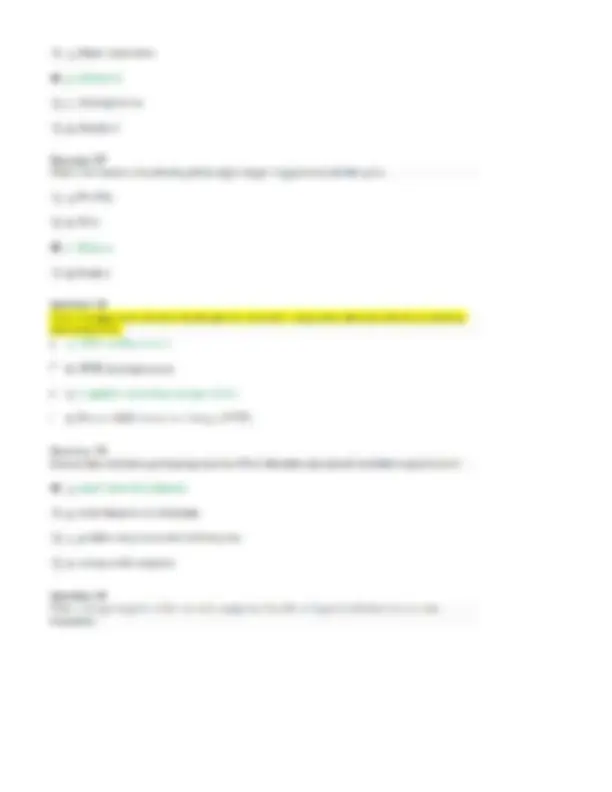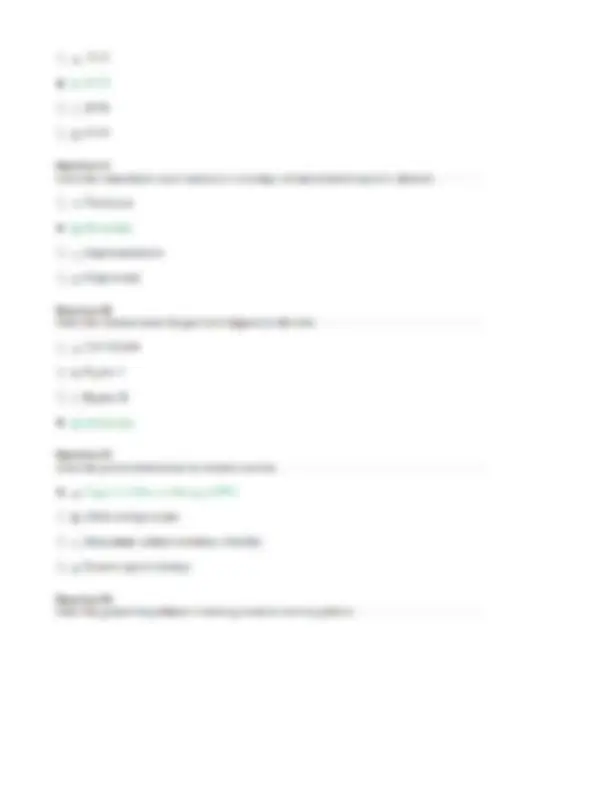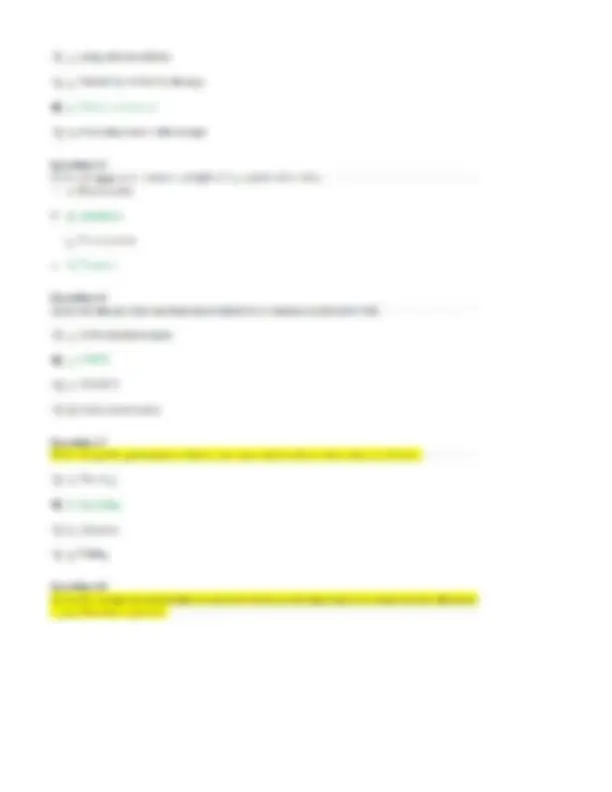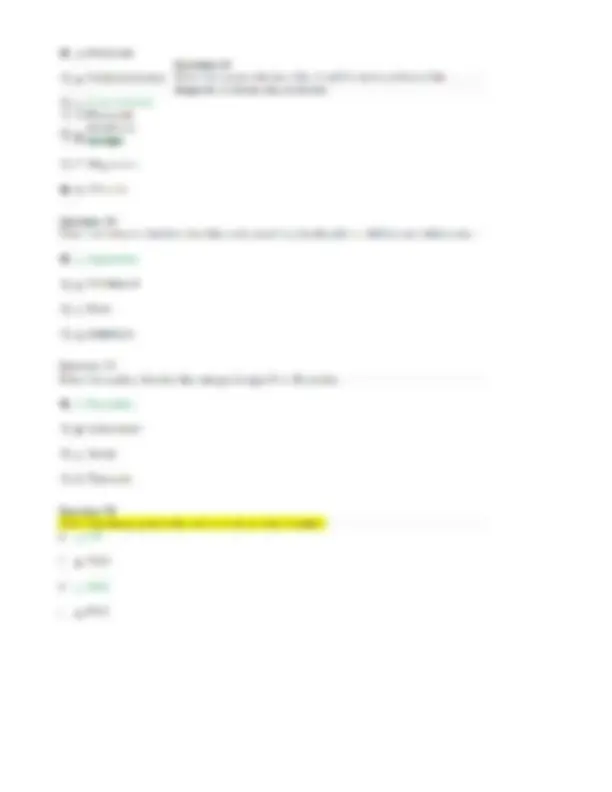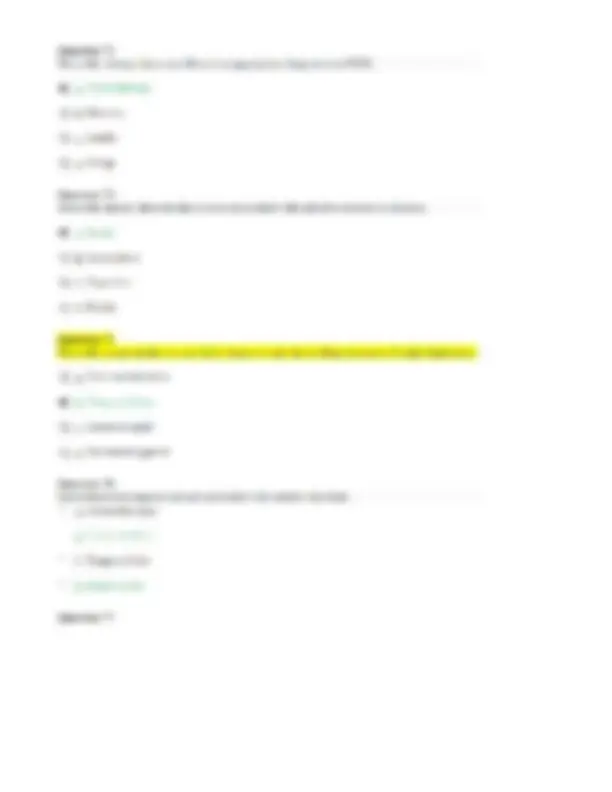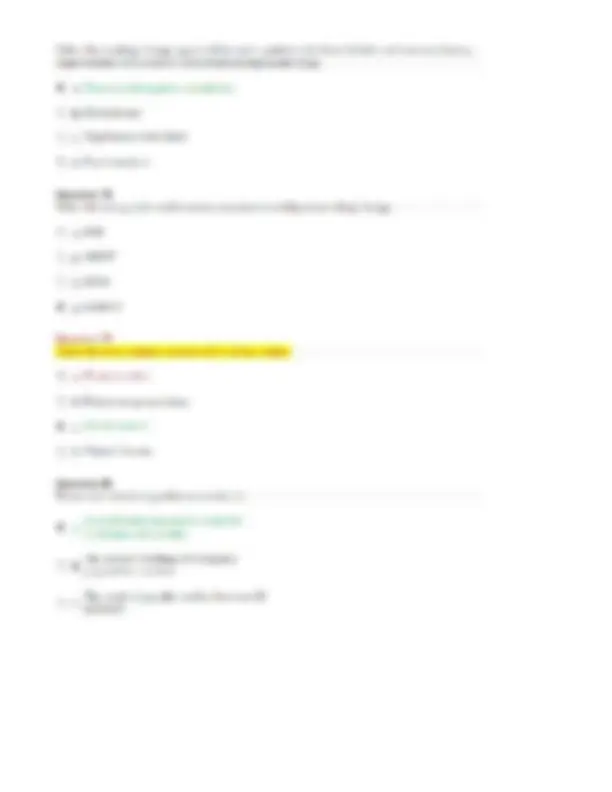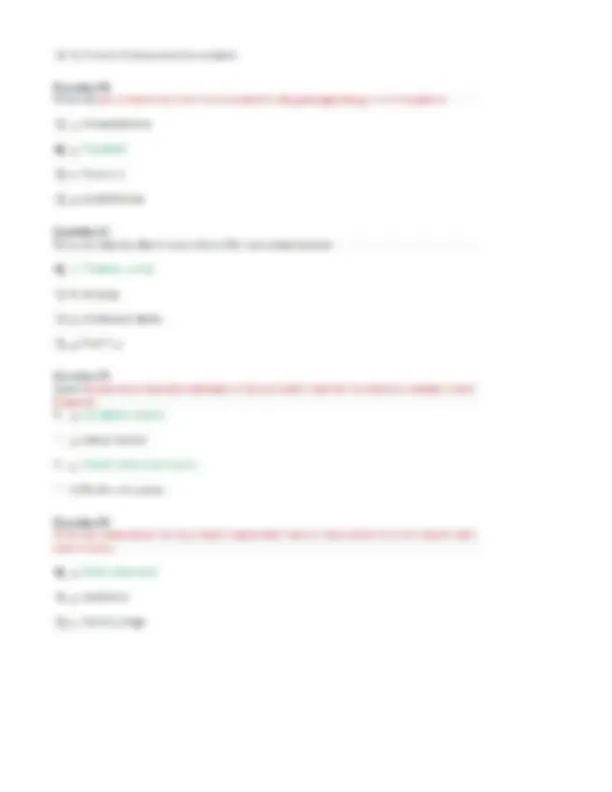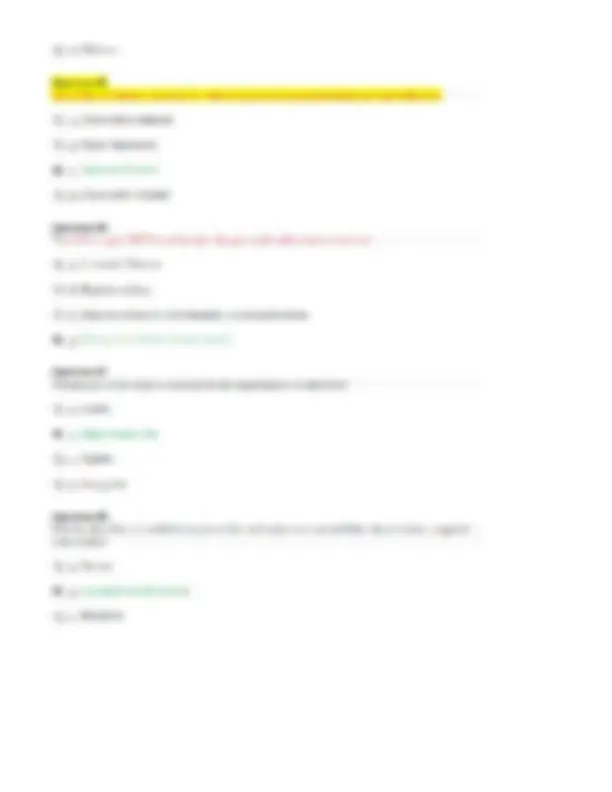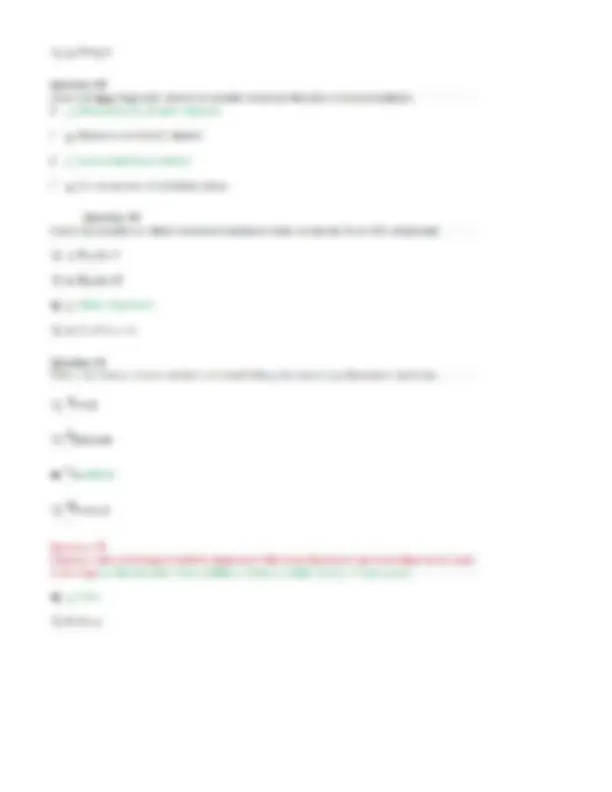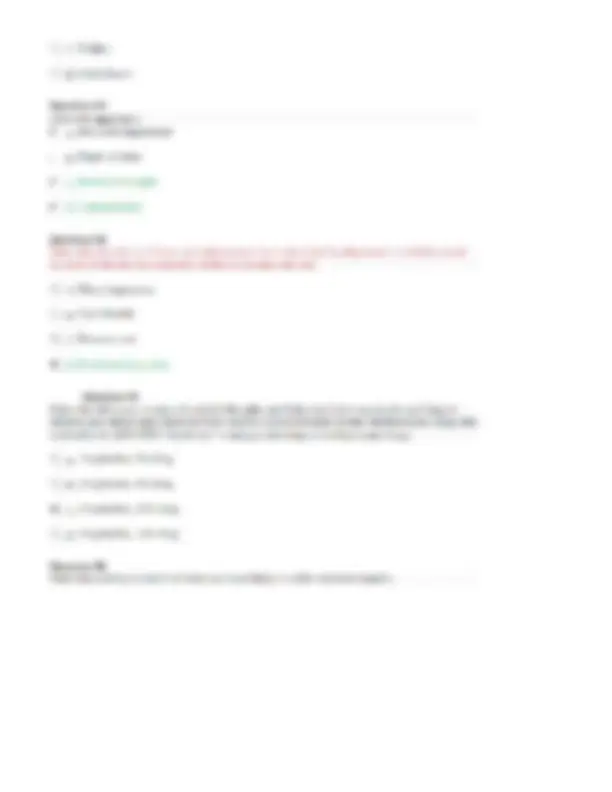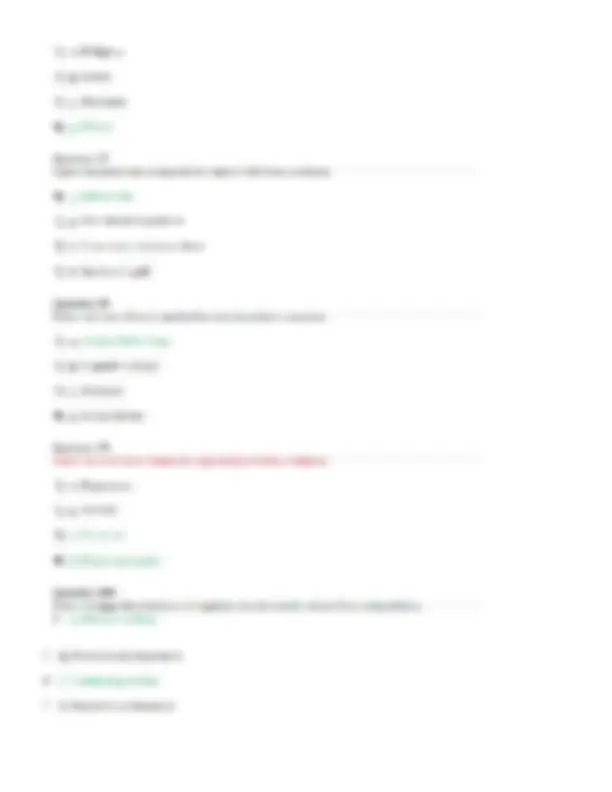Partial preview of the text
Download NRNP 6635 Midterm Exam (Version-3, 100 Q & A, Latest-2025) / NRNP6635 Midterm Exam: Walden and more Exams Nursing in PDF only on Docsity!
QUESTION 1 1. Select the serum assessment that is required when prescribing drugs to treat psychiatric disorders in psychosomatic patients. A. Potassium B . White blood cells C . Liver enzymes D . Blood urea nitrogen 1 points QUESTION 2 1. Select the theorist who developed the eight stages of psychosocial life cycle. A . Bowlby B. Perls C . Erikson D. Roger s 1 points QUESTION 3 1. Select two causes of dissociative amnesia. A . Sexual abuse B . Substance abuse C . Surgical pain D . Partner betrayal 1 points QUESTION 4 1. Select the patient evaluation scale to be used before and during preseribing antipsychotic drugs. A. MMSE B .. AIMS C. CAGE D. HAMD 1 points QUESTION 5 1. Select the two comorbid disorders with which Pica occurs most commonly. A. Enuresis B . Encopresis C . Autism D . Intellectual disability 1 points QUESTION 6 1. Select the prognosis range of untreated PTSD patients. A . 10% recover. 20% mild symptoms. 30% moderate symptoms. 40% no change or worse B . 20% recover. 10% mild symptoms. 40% moderate symptoms, 30% no change or worse C . 30% recover. 40% mild symptoms, 20% moderate symptoms, 10% no change or worse D . 40% recover, 30% mild symptoms. 10% moderate symptoms, 20% no change or worse | points QUESTION 7 1. Select the memory category retained in transient global amnesia that is absent in dissociative amnesia. A . Family members B . Sequential events C . Personal identity D. Adolescent years 1 points QUESTION 8 1. The following is NOT an endocrine change noted with anorexia nervosa: A . Increased Glucose B . Hypothyroidism C . Hypersecretion of corticotrophin-releasing hormone D. Eating with friends, but not family 1 points QUESTION 9 1. Select the two most important elements of the psychiatric interview to establish a mental illness diagnosis. A . Psychiatric history B . Family history C . Mental status examination D . Review of systems 1 points QUESTION 10 1. Select the greatest impediment to treating anorexia nervosa patients. A . Drug adverse effects B . Variability of family therapy C Patient resistance .D . Noncompliance with therapy 1 points QUESTION 11 1. Select the sleep disorder in which cataplexy is a common symptom. A . Central apnea B.. Somnambule nee C . Insomnia D . Narcolepsy 1 points QUESTION 12 1. Select the obsessive-compulsive disorder for which a patient is likely to initially seek help from a Primary Care Provider. A . Hoarding B . Excoriation C . Hair-pulling D . Body dysmorphia 1 points. QUESTION 19 1. Factors that indicate a good prognosis for PTSD disorders include all the following EXCEPT: A . rapid onset of symptoms B . short duration of symptoms C . positive response to benzodiazepines D . strong social supports 1 points QUESTION 20 1. Select the medical condition that must be excluded as a cause of somatic symptom disorder or hypochondriasis. A . Angina pectoris B . Asthma C Diabetes. D . Multiple selerosis 1 points QUESTION 21 1. What is the most IMMEDIATE consideration in assessing depression in adolescents? A . Sleep B . Safety C . Appetit e D. Anger 1 points QUESTION 22 1. Select the neurotransmitter that is most involved in the pathophysiology of schizophrenia. A . Norepinephrine B . Dopamine C . Serotonin D . Acetylcholine 1 points QUESTION 23 1. Select the most important component of the patient-provider rapport. A. Empathy B . Confidentiali ty C . Respect D . Privacy 1 points QUESTION 24 1. Select the most effective treatment for social anxiety disorder in children. A. Bupropion and SNRI antidepressants B . Cognitive-behavior therapy (CBT) and SSRI antidepressants C . Cognitive-behavior therapy (CBT) and amitriptyline D . Coaching approach behavior and leading by modeling 1 points QUESTION 25 1. All the following are key psychiatric findings when assessing speech and language in children EXCEPT: A . Normal articulation B . Unusual syntax C . Echolalia D . Repetitive stereotypical phrases 1 points QUESTION 26 1. Select the factor that is required to cause PTSD froma stressor. A . Intense horror B . Isolated experience C . Concurrent substance abuse D . Survivor's guilt 1 points QUESTION 27 1. All the following are classes of coping mechanisms in the Model of Mental Health as Resilience where humans overcome stressful situations EXCEPT: A. Adaptive involuntary coping mechanisms (defense mechanisms) B . Generativity versus Stagnation C . Conscious Cognitive Strategies D . Consciously Seeking Social Support 1 points QUESTION 28 1. Anatomical and functional neuroimaging studies have associated a decreased activation in what part of the brain with obsessive-compulsive behaviors? A . Bodmann's area B . Substantia nigra C . Caudate D . Wernicke's area 1 points QUESTION 29 1. Select the two complications in diagnosing patients with anorexia nervosa. Determining occurrence of substance abuse Denial of symptoms Insisting weight loss has a medical cause Secrecy regarding eating rituals 1 points QUESTION 30 1. Select the anxiety disorder that emerges in ages 9 to 18 months. A . Separatio nB. Generalized C . Social D . Traumatic 1 points QUESTION 38 1. Select the time from occurrence of the stressor in which symptoms must appear to diagnose an adjustment disorder. A. 1 week B. 1 month C . 3 months D. 6 months 1 points QUESTION 39 1. Select the serum substance that should be measured to aid the diagnosis of restless leg syndrome. A . Potassium B . Ferritin C . Magnesiu m D . Albumin 1 points QUESTION 40 1. Select the DSM-5 disorder formerly called multiple personality disorder. A. Depersonalizatio n B . Dissociative fugue C . Dissociative identity D . Derealization 1 points QUESTION 41 1. Differential diagnosis for consideration when suspecting a cyclothymic disorder include: A . Seizures B . Substance abuse C . Narcissistic Personality Disorder D . All of the above 1 points QUESTION 42 1. The following psychotherapy interventions is NOT a recommended in the treatment of PTSD: A. Behavioral Therapy B . Chelation Therapy C . Cognitive Therapy D . Hypnosis 1 points QUESTION 43 1. Select the difference in rates of suicidal thoughts and behaviors between placebo and drug in children and adolescents observed from random controlled trials of nine antidepressant drugs that resulted in the 2004 FDA "black box" warning in labeling of antidepressant drugs. A. 1% placebo, 5% drug B . 2% placebo. 4% drug C . 2% placebo. 10% drug D . 4% placebo, 12% drug 1 points QUESTION 44 1. Select the drug that has been effective in treating social anxiety in children. A . Bupropion B . Carbamazepi ne C . Amitriptyline D . Fluoxetine 1 points QUESTION 45 1. Select the youngest age range at which alarm therapy is effective to treat enuresis. A. 11 t012B.9to 10C.6t0o7D.5to6 1 points QUESTION 46 1. Which part of the brain is essential to the maintenance of attention? A . Cortex B. Right frontal lobe C . Septum D . Amygdala 1 points QUESTION 47 1. Select two signs and symptoms of bulimia nervosa. A . Weekly binge eating for at least three months B . Abuse of emetic drugs and substances C Greater weight loss than with anorexia . nervosa D . Binge eating and purging is most common in winter 1 points QUESTION 48 1. Select the behavior that best describes early onset bipolar disorder in children and adolescents. A. Aggression B. Withdraw al C . Panic D . Exhibition 1 points QUESTION 49 1. Select the most common stressor of PTSD in women. A. Home accident B . Partner or spousal abuse C . Sexual assault D . Natural disaster 1 points QUESTION 50 1. Select the most likely stressor to cause an adjustment disorder. A . Medical illness B . Natural disaster C . Vehicle accident D . Substance abuse 1 points C}] C, Somatic symptom @) D. Factitious Question 7 CP A.0.1-0.5 C} B.0.6-1.2 C] c.14-19 C) p.2.0-2.6 Question 9 s C) A. Fluoxetine C] B, Desipramine @) ¢. Venlafaxine ©} D. Bupropion Question 10 Select the psychiatric disorder that occurs most commonly in patients hospitalized for medical problems and surgery. C] A,Depression C) B, Adjustment ] Cc. Bipolar Shor t D. Anxiety Question 11 Select the short rating scale used to assess change in psychiatric inpatients. C] A.PANSS @| B. BPRS c] c.HAM-D C} D.CAPS i ee 12 C}] A. Opioid analgesics @) B. TCA and SSRI antidepressants C] c, Beta-adrenergic blockers C} D. Mood stabilizers Question 13 Select the medical condition that must be excluded as a cause of somatic symptom disorder or hypochondriasis. C} A. Angina pectoris ©] B. Asthma @) c, Diabetes }] D. Multiple sclerosis Question 14 Select the most commonly occurring eating disorder. C} A. Anorexia nervosa ©) B, Bulimia nervosa C] c. Purging @) Dp. Binge Question 15 Select the age stage of life in which identity crisis typically emerges. C) A. Childhood @) B, Serotonin ¢) Cc. Dopamine ¢) D. Gamma amino butyric acid (GABA) Question 20 Select the most likely stressor to cause an adjustment disorder. ¢) A. Natural disaster ¢) B. Emergency surgery @) c. Vehicle accident ¢) =D, Substance abuse Question 21 Select the cognitive function category in a mental status examination that is represented by the question, “Starting at 3 A.M., count back the time 2 hours at a time.” ¢) A, Orientation C) B. Concentration ¢) c, Calculation ¢) p. Alertness Question 21 Select the cognitive function category in a mental status examination that is represented by the question, “Starting at 3 A.M., count back the time 2 hours at a time.” ¢) A. Orientation @) B, Concentration ] c. Calculation ) D. Alertness Question 22 Select the memory category retained in transient global amnesia that is absent in dissociative amnesia. C) A. Family members C) B, Sequential events @) c. Personal identity ©) p, Adolescent years Question 23 Select the exposure to violence that is excluded as a DSM-5 diagnostic criterion for PTSD in children and adolescents. ®)] a Electronic media C) B. Directly witnessed ©} c. Report of family member ©] D, Repeated natural disaster — 24 @) «A Corticotrophin-releasing hormone C) B, Neuropeptide Y (] Cc GABA C} D, Galanin Question 25 Select the primary cause of reactive attachment disorder in children. C] A. Death of mother ] B. Bullying by peers @) c. Negligent parenting ©) D. Fetal alcohol syndrome uestion C) B.2 weeks @) C.1 month ) D.6 months Question 30 Differential diagnosis for consideration when suspecting a cyclothymic disorder include: C) A. Seizures. @] B, Substance abuse ©) C. Narcissistic Personality Disorder C] D.Allof the above Question 31 ©) A. Buspirone @] 5B, Sertraline C) c, Trazodone ©) D. Clonidine Question 32 Select the factor that is required to cause PTSD from a stressor. @] A Intense horror €] 8. Isolated experience €] Cc. Concurrent substance abuse ] D,Survivor’s guilt Question 33 ©] A. Bupropion and SNRI antidepressants @) B, Cognitive-behavior therapy (CBT) and SSRI antidepressants CC): C. Cognitive-behavior therapy (CBT) and amitriptyline ¢] D, Coaching approach behavior and leading by modeling Anatomical and functional neuroimaging studies have associated a decreased activation in what part of the brain with obsessive-compulsive behaviors Question 34 Anatomical and functional neuroimaging studies have associated a decreased activation in what part of the brain with obsessive-compulsive behaviors? ¢) A,Bodmann’s area C) B. Substantia nigra @) Cc. Caudate C]) D. Wernicke’s area Question 35 Select the DSM-5 disorder formerly called multiple personality disorder. C] A. Depersonalization ¢) B. Dissociative fugue @) ¢. Dissociative identity C) D.Derealization Question 36 Select the two factors that do not cause dissociative amnesia. [ A. Sexual abuse [* B, Substance abuse Mc. Surgical pain {— D, Partner betrayal Question 38 Select the population in which rumination disorder occurs most frequently. What is one main difference between acute stress disorder and PTSD? @] A.PTSD diagnosis require symptoms to last at least for one month. (] B. Acute stress disorder symptoms can last at least for one month. ©) C. PTSD has recurrent, distressing dreams. () D.Acute stress disorder has recurrent, distressing dreams. Question 42 C) A. Bradycardia ©) B, Relaxation of skeletal muscles @) Cc, Dreaming () D.Tachypnea Question 43 Select the fwo medical conditions in which derealization and depersonalization are common. A, Anorexia [ B. Migraine [— c. Parkinson’s [* Dp, Seizures Question 44 Select the disorder in which children are irritable and display temper outbursts, but are not likely to cause physical harm to themselves and others. @) A. Oppositional C) B. Conduct €) C. Dysregulation C) D. Bipolar Question 45 Select the type of dissociative amnesia described by patient’s inability to recall any information about her or his family. ) A. Selective C} B, Localized ©] C. Continuous @) D.Systematized Question 46 Select the mood disorder in which diagnosis requires symptoms present for at least two years. ©) A. Major depression ©) +B. Dysthymia ©) «C. Bipolar II ¢) Dp. Cyclothymia Question 47 Select the criteria in DSM-5 to diagnose a child with major depressive disorder. ) ~A.At least three symptoms including suicidal thoughts for three weeks ¢) 8B, Atleast five symptoms including violence toward others for three weeks ¢] = C. At least three symptoms excluding substance abuse for two weeks @) D.At least five symptoms including irritable mood for two weeks Question 48 Select the time after cessation of the stressor causing an adjustment disorder in which symptoms should cease to persist. ¢) A.1 month ¢) B.3 months @) C,6 months ¢] D.l year 
